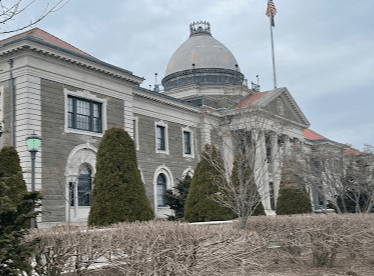|
Getting your Trinity Audio player ready...
|
Queens Woman Arrested for Defacing Theodore Roosevelt Statue with Blood-Like Liquid During Anti-Israel Protest
By: Fern Sidman
A weekend anti-Israel demonstration in Mineola, Long Island, took a dramatic and destructive turn when a Queens woman allegedly defaced a public monument of former President Theodore Roosevelt by throwing a thick, blood-colored liquid on it, according to law enforcement officials and court records cited by The New York Post.
The protest, which took place on Saturday outside the Theodore Roosevelt Executive and Legislative Building on Franklin Avenue, was described as largely peaceful—until Allyson Fairbanks, a 60-year-old resident of Briarwood, Queens, allegedly threw a dark red substance resembling blood onto the statue of the 26th president of the United States.
According to the information provided in The New York Post report that appeared on Wednesday, the liquid splashed across the bronze statue and severely stained the stone placard beneath it, with the substance soaking into the stone and causing what law enforcement described as a “significant stain.”
The act of vandalism was reportedly committed in full view of protest participants and onlookers, though Fairbanks allegedly fled the scene before she could be apprehended.
Nassau County Police launched an investigation into the incident over the weekend, and by Monday, authorities had tracked down and arrested Fairbanks. She has been formally charged with second-degree criminal mischief and making graffiti, according to the criminal complaint obtained by The New York Post.
Fairbanks appeared in court for arraignment on Tuesday and was released to pre-trial services pending further legal proceedings, the Nassau County District Attorney’s Office confirmed. She is scheduled to return to court on April 4.
According to prosecutors, the blood-red liquid not only blemished the appearance of the statue, but also permanently damaged the historic stone base, raising concerns about restoration and cleanup costs. Officials have not yet disclosed the full extent of the damage or the anticipated cost of repairs.
The act has sparked outrage among local leaders and residents, not only for its desecration of a historical monument but also for the injection of vandalism into an otherwise peaceful protest. As The New York Post report noted, the protest was initially organized to express opposition to Israel’s policies—part of a wave of similar demonstrations occurring across the country. However, Fairbanks’ actions overshadowed the demonstration’s message, with headlines now dominated by her arrest and the damage to public property.
The statue targeted in the incident stands in front of the Theodore Roosevelt Executive and Legislative Building, a major civic structure in Nassau County named in honor of Roosevelt, who served as Governor of New York before becoming President of the United States, The New York Post report said. Though some of Roosevelt’s monuments have become controversial in recent years, especially those that include colonial or imperialist imagery, the Mineola statue has not been the focus of significant protest activity until now.
The use of a red, blood-like liquid to vandalize the statue was immediately interpreted by law enforcement and observers as a highly symbolic act—possibly intended to link Roosevelt to broader themes of violence or oppression, though Fairbanks herself has not made any public statement clarifying her motivations.
The charges against Fairbanks—particularly second-degree criminal mischief, a felony offense in New York State—carry potential serious consequences, including jail time and significant fines if she is convicted. Her release to pre-trial supervision suggests that the court does not view her as a flight risk but underscores the seriousness of the alleged crime.
While the protest itself was legal and protected under First Amendment rights, authorities emphasized that vandalism and property destruction cross a legal line, regardless of political context or intent.
As the case develops, it is likely to stir debate not only about freedom of expression versus criminal conduct, but also about the tone and tactics of protest movements—particularly those connected to controversial international issues such as the Israel-Palestinian conflict.
The defacement of the Roosevelt statue follows a broader national pattern in which monuments and historical symbols are increasingly becoming targets during political demonstrations. While most protests remain peaceful, law enforcement agencies across the country have reported a rise in graffiti, vandalism, and symbolic acts of defacement—often accompanied by heightened political polarization.
In this case, as The New York Post report indicated, Fairbanks’ act has drawn law enforcement attention away from the demonstration’s original focus and refocused it on the criminal consequences of individual misconduct.
As Fairbanks prepares to reappear in court on April 4, the Nassau County District Attorney’s Office is expected to pursue the case aggressively, citing both the symbolic and material damage caused by her actions. Restoration experts may be consulted to assess the extent of the staining and determine whether the statue and its base can be fully cleaned.
Meanwhile, civic leaders in Mineola and Nassau County are calling for increased security around public monuments, particularly during protests, to prevent future acts of vandalism, as was noted in The New York Post report.
Fairbanks has not yet commented publicly, and her legal counsel has not issued a statement as of the time of reporting.
The case stands as a cautionary example of how a single act can derail a public demonstration, spark legal action, and shift public discourse away from political messages to questions of law, accountability, and respect for public property.





Vandalism. Charge her for the cleaning of it.